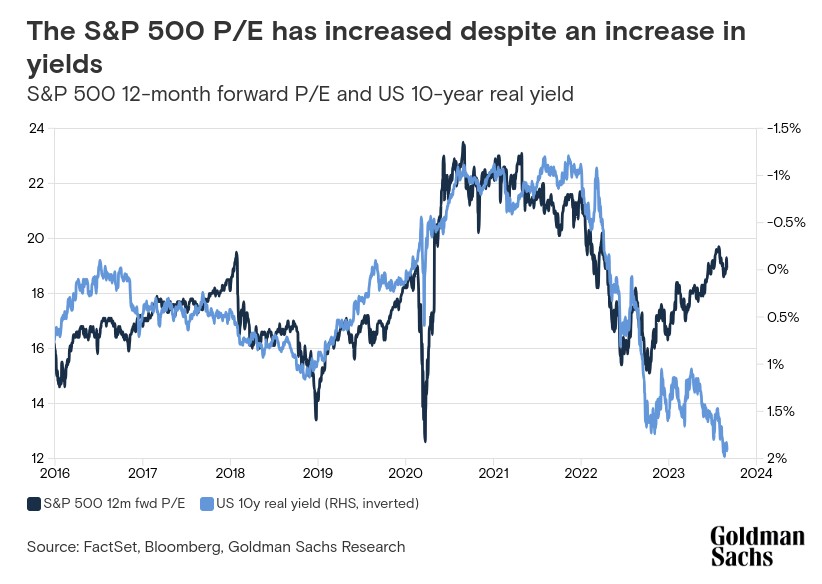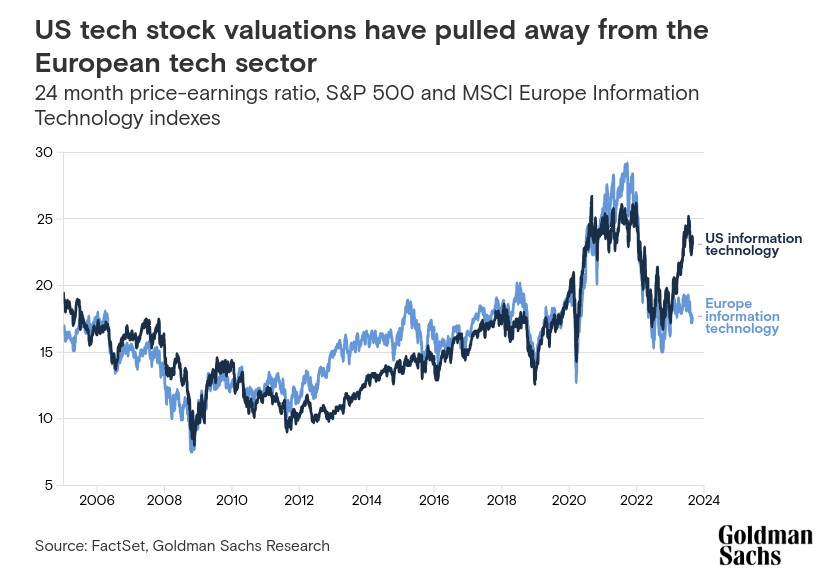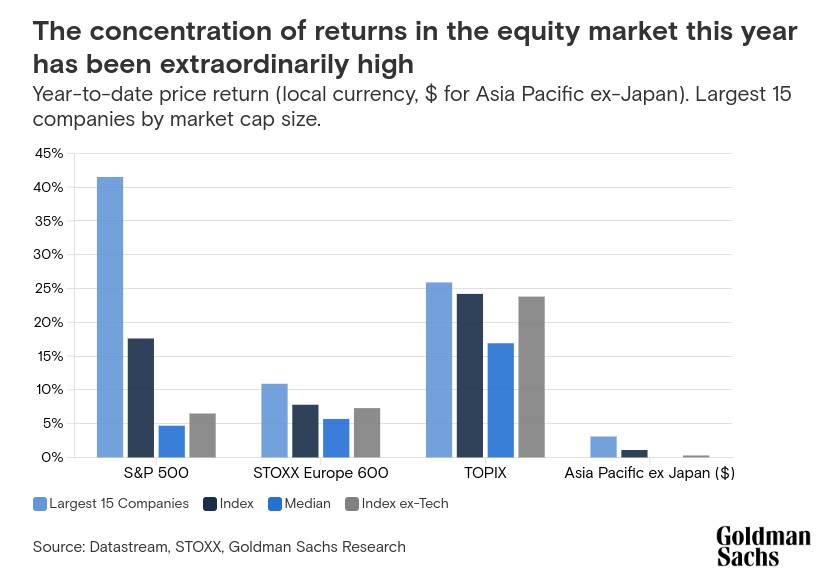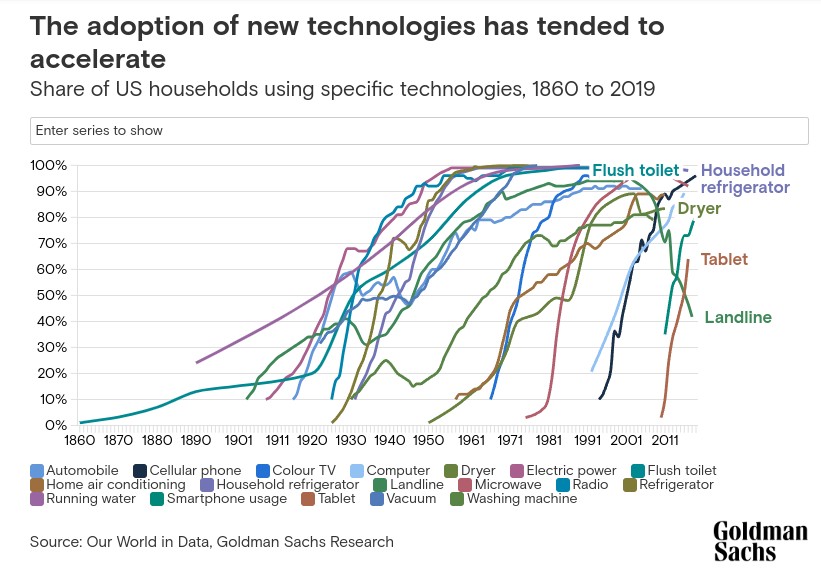We would like to thank our generous sponsors for making this article possible.
The explosion of interest in artificial intelligence this year has fueled a major rally in technology stocks, with a concentrated group of large US companies leading the market higher. This slate of “early winners,” including makers of semiconductors needed to build AI technology and cloud service providers with the computing infrastructure to commercialize it, returned roughly 60% through the first eight months of 2023, according to Goldman Sachs Research.

Even as those stocks have rallied substantially, they don’t appear to be in a bubble, Peter Oppenheimer, chief global equity strategist in Goldman Sachs Research, writes in the team’s report. The valuations of the stocks leading the market are not as stretched as in previous periods, such as the internet bubble that collapsed in 2000, and the companies have unusually strong balance sheets and returns on investment. “We believe we are still in the relatively early stages of a new technology cycle that is likely to lead to further outperformance,” Oppenheimer writes.
Technology stock valuations have climbed this year despite the impact of rising rates. This is in sharp contrast to 2022, when the sector’s sensitivity to rising discount rates depressed valuations, and it suggests investors are assuming much higher future growth rates for these companies.

US technology sector valuations, meanwhile, have developed an unusual premium relative to technology companies in Europe. This shows how important the AI narrative has been to the market’s gains, given that most of the leading companies in this area are US-based.
From our partners:

But the rally has been concentrated. Just 15 companies accounted for more than 90% of the returns of the S&P 500 Index from January through June. “Since many of these early winners are very large companies, the concentration of returns in the equity market this year has been extraordinarily high,” Oppenheimer notes.

This has naturally raised questions about a potential bubble and the possible implications of the concentrated market leadership.
Are tech stock valuations too high?
Technology sector valuations are certainly high by historic standards, according to Goldman Sachs Research. Compared with the 10-year median and range, the current price-to-earnings (P/E) ratio for the US technology sector is right at the top. But that’s not the whole story. The seven biggest US companies seen as leaders in the race to commercialize generative AI technology have an average P/E of 25. That compares with a P/E of 52 for the biggest companies at the peak of the internet bubble. The leading companies in the “Nifty 50” bubble of the late 1960s had a P/E over 34.
The US market as a whole is also at the top of its 10-year range for valuation, but this is being driven by the tech leaders. When large technology companies are excluded, the market’s valuation looks more in line with historical levels. What’s more, the biggest companies in Europe, not all of which are in technology, have a much lower valuation than the equivalent list of dominant companies in Europe during the tech bubble of the late 1990s. “Not only are the leading tech companies less extreme in valuation today, but the broader optimism that spilled over into equity valuations in the late 1990s is not apparent today,” Oppenheimer writes.
There’s more to contrast today’s AI-related stock market excitement to the exuberance of the internet stock bubble. Long-term growth expectations for the US technology sector have increased recently, but they remain well below the expected growth rates implied in the late 1990s.
And the current crop of technology leaders are already very profitable and generate cash, meaning they are investing at a high rate even in an environment of elevated interest rates and borrowing costs. Their cash as a percentage of market capitalization is double what companies had during the internet bubble. Their return on equity and average margins are also nearly double what was seen during the 1990s runup. “This has made these companies relatively defensive in terms of their revenues and earnings,” Oppenheimer notes. These companies are increasing their “moats” and raising the prospects for future growth.
To be sure, history provides numerous examples of technology waves that spur investor interest and exuberance and then inflate a bubble that eventually bursts — from canal stocks in the 1790s to internet stocks in the 1990s. A study that looked at 51 major tech innovations from 1825 to 2000 found investment bubbles were evident in 73% of the cases.
From that history of technology cycles, though, it’s possible to see patterns and common characteristics. After speculation builds and a bubble inflates and deflates, “the technology tends to re-emerge as a principal driver in the stock market,” Oppenheimer writes. Secondary innovations emerge, creating new companies and products; other industries are disrupted by the innovations, forcing incumbents to either adapt or recede.

A framework for classifying in AI stocks
Examining the characteristics of prior waves of technological innovation — and the investment bubbles that often came with the change — can be helpful to understand current investment in AI-related stocks and future opportunities.
Oppenheimer says the PEARLs framework based on historical patterns may help investors think about how AI technology may create winners and losers in business and in the stock market. It divides companies into five groups: Pioneers, Enablers, Adapters, Reformers, and Laggards.
Pioneers are the innovators, and they include the early winners. “While the pioneers may be easiest to identify early on, they are not always the biggest beneficiaries,” Oppenheimer writes. New entrants may be nimbler. New innovations may emanate from the original technological advances, creating a later class of pioneers.
Enablers facilitate the innovators and help to commercialize the technology. These companies are also easy to spot early. What’s harder to know is how they will fare longer-term, Oppenheimer notes. In the internet buildout, telecom companies were enablers that mostly failed to justify inflated valuations, while semiconductor companies did better, in part because large capital investments helped to create barriers to entry.
Adapters are companies in other industries that change their business models to use the new technology effectively. With the spread of generative AI solutions, we may see big winners among companies that can adopt AI to improve healthcare or educations services, for example. “Many of the benefits may accrue to consumers in the form of cheaper new services,” Oppenheimer writes.
Reformers are typically new market entrants unencumbered by legacy costs. Think of online retailers, car-sharing apps, and online banks. “Such companies can disrupt a mature non-technology industry by utilizing the innovations to create a new business model that is more scalable than those of existing competitors,” Oppenheimer writes.
Laggards may have a dominant incumbent position in an industry, but, for whatever reason, react slowly and fail to keep up with new innovations. Going back to an earlier period of technological change for examples, we can point to photography companies that built strong incumbent positions based on their own innovation and then lost it all when digital photography displaced them.
While the success and eventual impact of an innovation can’t be known at the outset, Oppenheimer says the PEARLs framework can help investors focus on the companies that may be most likely to succeed over the long run.
For now, as investors weigh the potential for new AI technology and look for a way to share in the gains, they may spread investments across multiple companies as options on their future success. This has happened in the past, adding to the tendency to push the total valuation of companies exposed to a new technology to a level that exceeds the growth that can be generated — and creating bubbles. Despite the enthusiasm around AI, Oppenheimer suggests there’s little evidence of that happening so far.
Originally published at: Goldman Sachs













